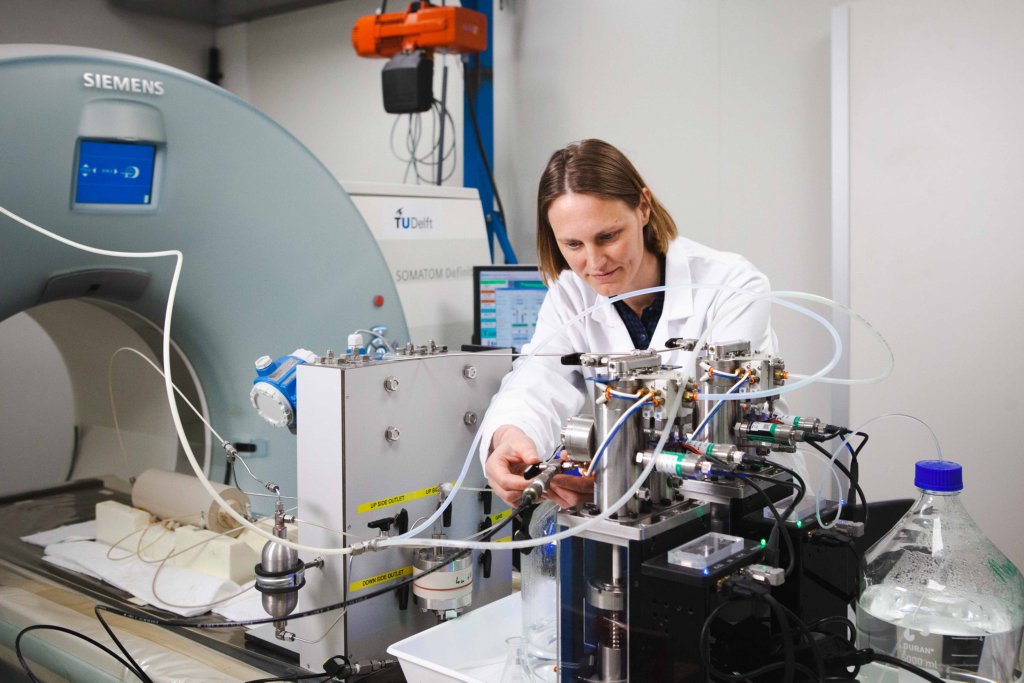Energizer Maartje Boon
Maartje works in the Reservoir Engineering section in the department of Geoscience & Engineering at TU Delft, where she holds a postdoc position and leads the ADMIRE hydrogen lab. This is her second postdoc position, previously she was a postdoc at the Energy Resources Engineering department of Stanford University. She obtained a PhD in Petroleum Engineering from Imperial College London.
The energy transition and hydrogen
In the transition from fossil fuels towards sustainable fuels, hydrogen could play an interesting role. When there is peak in renewable energy supply, the surplus can be used to convert water into hydrogen through electrolysis, which than can be stored in the subsurface and retrieved when needed. The idea is to store hydrogen underground because of its low density and the sheer abundance of the gas. On-surface storage facilities can’t compete to the vastness of subsurface porous reservoirs.
Hydrogen: exploring uncharted territories
Maartje has been working on CO2 storage for 10 years and knows subsurface gas storage is a proven concept. However, little is known yet about hydrogens behaviour when stored underground. There are new questions to be answered, such as: will we be able to efficiently extract the stored hydrogen from subsurface storage reservoirs? Does hydrogen react with the subsurface minerals? How can we best prevent leakages?
To Maartje doing research on underground hydrogen storage is like exploring uncharted territories: you need to think about measuring the right parameters before you design experiments and use the output of experiments to feed the simulation models.

Seeing through the lens of a medical CT scanner
“The medical CT scanner you see in the picture lets us “look inside the porous rock”. We can visualize how the water and gas flow together through the heterogeneous pore space of the rock. This allows us to better understand the complex flow behaviour that takes place in the subsurface during repeated injection and production cycles.
In the Geoscience Engineering laboratory, we do various experiments with rocks and brine (salty water) to be able to predict multiphase flow: how do brine and gas flow together through porous rock? How easy can the gas be injected and extracted from the reservoir rock? and what amount of hydrogen will get lost in this process due to trapping and bio-geochemical processes?”
Small molecules can pose major challenges
“It’s not easy to get the experiments right, hydrogen is a very small molecule, especially compared to the CO2 molecule, so we often take extra precautions to prevent leakage within the experiments. Therefore, the set-up of the experiments takes more time. Luckily I work together with a great team of technicians and students in the lab, they are very skilled at dealing with the technical practicalities. Working with such a great team is not always a given.”
Keep calm and carry on
When Maartje encounters difficulties in the experiments she tries to keep calm and carry on. It takes patience to take in a set-back and creativity to find new solutions. Maartje also divides her time between experimental work and numerical modelling. The true scientific challenge is to choose the experiments in such a way that they yield the best basis for numerical modelling and a fundament for future work.
Maartje: “What keeps me going is also the notion that the energy transition is accelerating. You see fluctuating energy prices, a high sense of urgency in energy supplies. Everyone is much more geared towards the energy transition. This makes it worthwhile to work on this research topic. What I also like about it, is that the challenge calls for a multi-disciplinary approach to come with solutions.”
Working together across disciplines
According to Maartje, thinking of the multi-disciplinary approach to find solution is exactly where the 4TU.Energy community plays a role. “I really like meeting with fellow scientists with different expertise like for example microbiology. Microbes are expected to be abundant in subsurface porous reservoirs and could have a significant impact on the storage process as the stored hydrogen can be used in their metabolism. What interests me is to find out more about these microbial processes and how it would affect the storage and retrieval of hydrogen from subsurface storage reservoirs.”
Contact Maartje Boon, visit the website of TU Delft.